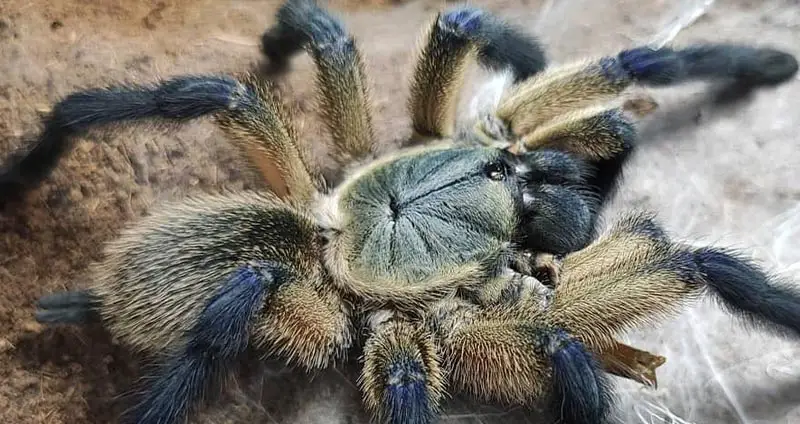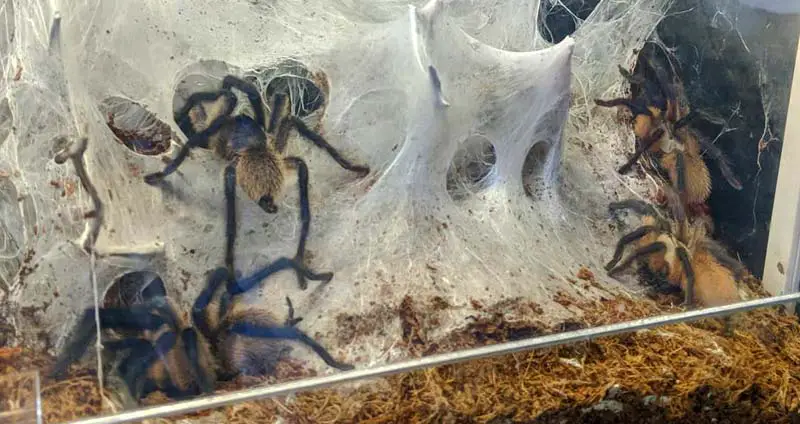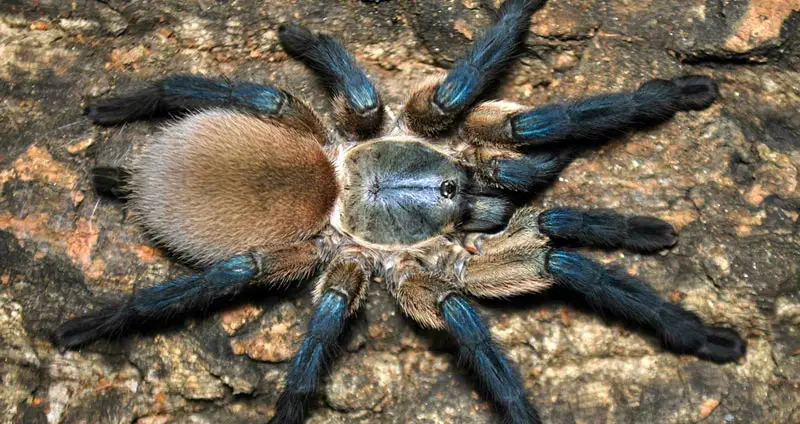With the hundreds of tarantulas in existence, there’s bound to be some that stick out from the rest. Monocentropus balfouri, also known as the Socotra Island Blue Baboon tarantula, is one of the most fascinating and sought-after tarantulas by experienced keepers in recent years.
There are several different traits that make this tarantula so unique and may make it a great addition to your personal collection.
If you’re looking to bring home one of the tarantulas for yourself, there’s a few things that you should know about them. This post will cover the M. balfouri‘s great appearance, unique personality, and special environmental and care needs.
Table of Contents
Monocentropus balfouri Care Sheet
Common Name |
Socotra Island Blue Baboon |
Species Type |
Old world terrestrial |
Habitat |
Found off the coast of Yemen in Socotra Island — a home to several other popular exotic pets. It boasts quite a hot and dry climate with low humidity levels year-round. |
Growth Rate |
Medium growth rate. Females and males reach full size within a couple of years. |
Adult Size |
Females reach a legspan of between 6″ and 7″, with males measuring slightly smaller. |
Lifespan |
Females regularly live to be around 12 years old, while males often only live between 3 and 4 years. |
Enclosure |
The enclosure should be substantially longer than it is tall. It should be filled with several inches of substrate that allow for deep burrows. The enclosure should also have a sizable hide and a water dish. |
Temp/Humidity |
76°F to 82°F with about 60% to 70% humidity. |
Diet |
Good eater that can eat several adult crickets or one dubia roach per week. Their diet can be supplemented with mealworms. |
Temperament |
Quite fast-moving and aggressive tarantulas that spend most of their time in their burrow. They do possess the ability to live communally as long as enough food is present, though. |
Experience Level |
Intermediate – A tarantula species suited for more experienced keepers. Its personality isn’t very agreeable, and it doesn’t like to show itself off very frequently. |
Average Cost |
Slings ~ $50, Males ~ $75, Females ~ $150+ |
Monocentropus balfouri Appearance
This tarantula species actually won Best In Show in the 2014 British Tarantula Society Exhibition. Its looks are unmatched by most other species, and they’re a tarantula that simply draws one’s eyes.
The contrasting colors between the tan/gold body and the rich blue legs is not something commonly seen. This appearance certainly isn’t present in other Baboon tarantulas.
These tarantulas aren’t always this beautiful, though. As spiderlings, they tend to be a grayish-brown, get more gray as they start to grow into juveniles, and finally developing their blue coloration as they reach maturity after a molt or two.
Definitely more of a “sleeper” species than some other tarantulas.
As far as sizing goes, Monocentropus balfouri is right about as average as a tarantula can get. Adults typically grow to have a legspan between 6-7″, and they reach their max size at a fairly average rate, too.
So in short, this is a tarantula that doesn’t come with a lot of bells and whistles, but still has one of the most striking appearances today.

Monocentropus balfouri Temperament
The temperament of this species is what makes it so fascinating to so many people — myself included. They’re certainly not tarantulas that are beginner friendly, and you need to take extra care when around them.
However, they exhibit behavior that’s quite different from other similar tarantulas, especially of the Baboon type.
Monocentropus balfouri are old world tarantulas, which are tarantulas that are known for their shorter temper, aggressive personality, and much more painful bite.
In short, this type of tarantula typically isn’t recommended for inexperienced owners and should almost never be handled.
While this species is no exception to that definition, they do have some surprising traits that make them quite different.
To begin with, these tarantulas are incredibly quick and quite aggressive if pestered, so it’s not recommended that you handle these.
Additionally, like other Baboon tarantulas, Monocentropus balfouri will spend most of its time down in its burrow. So, if you’re looking to invest in a more “present” tarantula, you might want to look elsewhere.
However, experienced keepers will still absolutely enjoy this species.
Perhaps the most fascinating characteristic of this species is their ability to be communal. Most tarantulas need to be kept in their own enclosures or else they’ll likely fight and kill each other.
M. Balfouri, though, will gladly live with other members of its species if enough food is provided to prevent cannibalism.
On top of that, strong maternal care has been observed in these tarantulas, with mothers killing insects and bringing them into their burrow for their spiderlings to eat.
This is a trait that’s extremely rare in other tarantulas and makes this a great species for people that are interesting in breeding their tarantulas.
Housing Monocentropus balfouri
If you want to take home a Monocentropus balfouri for yourself, especially if you plan on breeding them, you first need to ensure that you can meet their environmental needs.
Also, since these tarantulas are incredibly quick and pack quite a punch with their bite, you’ll want to create an enclosure that doesn’t need to be messed with frequently.
Optimal Enclosure
Monocentropus balfouri have special requirements for their enclosures, but those requirements aren’t hard to meet. To begin with, these are terrestrial tarantulas that have a strong desire to burrow.
Therefore, their enclosure should have a good amount of floor space without much height to it. Additionally, they’re very heavy webbers, so their enclosure needs to have several anchor points for that webbing such as sticks and rocks.
For a single tarantula, an enclosure that’s similar to this Exo Terra 18″ x 18″ x 12″ glass terrarium would provide them with enough space to burrow.
However, an enclosure with several specimens will need to be longer and wider, as this species doesn’t share their burrows with each other.
This particular enclosure is great due to its front-opening door and height that’s tall enough to give you access to the inside while not allowing the Monocentropus balfouri to dart out.
Enclosure Decorations
The inside of the enclosure should have a few different accessories in order to meet the environmental needs of this species.
First and foremost, since this is a terrestrial species, there needs to be about 6 inches of moisture-retaining substrate lining the bottom of the enclosure. Coconut fiber substrate works great.
This substrate allows for burrowing and also keeps the enclosure clean and consistently-humid.
On top of the enclosure you’ll want to supply a tarantula hide (or several in a communal setup) to provide a webbing anchor point and a place to feel secure.
A water dish is also essential as it prevents dehydration and contributes to the enclosure’s humidity.
Other than those accessories, not much else is needed. These tarantulas fill up the majority of their enclosure with webs, so leave them plenty of space to do this.

Enclosure Temperature/Humidity
First of all, it’s important to note where this tarantula species is from. Socotra Island lies off the coast of Yemen and is home to several other popular exotic pets. It boasts quite a hot and dry climate with low humidity levels year-round.
To match the temperature of the Socotra Archipelago, you should keep your tarantula’s enclosure around 76°F to 82°F. Room temperature is perfectly acceptable for most enclosures, so supplemental heating isn’t needed.
If your house frequently gets much cooler than this range, though, you may want to utilize either a space heater or a gentle heat lamp that doesn’t emit light.
In terms of humidity, aim to keep the enclosure between 60% and 70%. To maintain this, simply keep the water dish full and mist one side of the enclosure about 3 times per week.
It’s recommended that you use a thermometer/hygrometer to measure the enclosure’s conditions so that you can make small adjustments as needed.
Diet
The Socotra Island Blue Baboon Tarantula grows at a decent rate and definitely grows into its beautiful colors. In order to make this transformation, they need to have a nutritious diet that satisfies their appetite.
Fortunately, this is an easy species to feed, and they’ll gladly eat a mixture of crickets, roaches, and locusts.
If you’re opting to keep your Monocentropus balfouri in a communal setup, you need to take extra care with their feeding. Even those these are communal tarantulas, they will quickly resort to cannibalism if food is scarce.
Since tarantulas can’t be overfed, it’s always best to feed colonies more food than you think they need in order to avoid disaster. Also note that mothers will tend to stash food away for their spiderlings.
Health Concerns
Fortunately, captive tarantulas tend to not experience any serious health problems. If you supply your Monocentropus balfouri with an appropriate enclosure and a nutritious diet, they shouldn’t run into any issues health-wise.
The only issues that captive tarantulas run into are generally dehydration and parasites/mites — things that are easily avoided and dealt with.
There are two important things to note when it comes to this species of tarantula. First of all, you need to make sure that it has plenty of space to create burrows — especially if you’re keeping a colony.
Your tarantulas can start exhibiting strange or destructive behavior if they’re not able to burrow, so this is an essential part of their enclosure.
Additionally, some tarantulas may experience a problem with their molt. While most molts happen without a problem, they can sometimes get stuck.
If this happens, it’s dangerous but essential that you help your tarantula complete their molt. Fortunately, there are quite a few guides online that tell owners how to best go about helping to remove their tarantula’s exoskeleton.
Monocentropus balfouri For Sale & Price
Socotra Island Blue Baboons aren’t the most commonly-kept tarantulas due to their more aggressive personality and relative difficulty to keep.
Since this is a species that doesn’t have incredibly high demand, they’re a bit less common and thus fetch a higher price.
Several online marketplaces and breeders are selling Monocentropus balfouri for a very reasonable price. You can typically find a spiderling being sold for around $50, and this usually includes a good health and safe arrival guarantee.
They may become cheaper in the future, but even now they’re being sold for a relatively good price for such an interesting tarantula.
Overall, for $50, you really can’t beat the value you’re getting with a healthy Monocentropus balfouri. These are such unique tarantulas that were deemed “best in show” and continue to be praised for their brilliant looks.
While they are still old world tarantulas and don’t have the friendliest personalities, they are more than interesting to observe — especially if you intend on keeping them in a communal setup.


I can’t get enough of this T. One of my favorites by far!
Hi! I have 2 questions concerning this m balfouri…I just acquired mine last Monday. I’m told that it is now a very young juvenile, and to give small crickets when I do actually see her/him outside of its burrow(s). Needless to say, I have not caught a glimpse yet. Could I just drop small cricket in any of the 3 holes to be seen? With the substrate needing to be somewhat moist, so as to enable burrowing, on average how frequently would one need to actually rehouse tarantula then??? Mine arrived home in a 4” square plastic enclosure. Could I ask for any pointers you would wish to share on rehousing? And anything else would be greatly appreciated…thanks!
Hey Steve! Very good questions. It’s generally not recommended that you drop feeder insects into a tarantula’s burrow. When they get hungry and need to eat, they’ll come up and hunt, so just keep a cricket or two in the enclosure! In terms of rehousing, owners typically rehouse twice — once when the tarantula leaves their sling stage and another when they’ve almost reached their full legspan. You don’t want to rehouse a lot, so those are good milestones to do it at. A 4″x4″x4″ square box is pretty small so you should look to upgrade that soon. While Monocentropus balfouri is a relatively fossorial species, it still needs enough space so that it doesn’t feel cramped. This container would be a great and cheap upgrade for the time being >> https://amzn.to/2C2OsW1. As for the process of rehousing, there’s tons of videos available on YouTube showing how to do it. It’s not very difficult but it requires some know-how. Hope this helps!